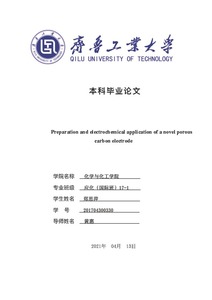Preparation and electrochemical application of a novel porous carbon electrode
Zheng, Siping (2021)
Zheng, Siping
2021
All rights reserved. This publication is copyrighted. You may download, display and print it for Your own personal use. Commercial use is prohibited.
Julkaisun pysyvä osoite on
https://urn.fi/URN:NBN:fi:amk-2021072516848
https://urn.fi/URN:NBN:fi:amk-2021072516848
Tiivistelmä
With the continuous development of science and technology and the improvement of people’s living standards. And in order to meet the growing demand for energy, the research and development of new high-performance sustainable energy storage devices such as lithium-ion batteries, supercapacitors, has been an important subject of scientific researchers. Supercapacitor, also known as an electrochemical capacitor, is a new type of energy storage device using electric double layer or pseudocapacitance to store electric energy. Compared with the secondary battery, it has higher power density, shorter charge-discharge time and higher cycle times, but its disadvantages are also obvious, such as low energy density and a small amount of charge in operation.
Carbon materials are the most commonly used electrode materials for supercapacitors because of their excellent electronic, optical, catalytic and electrochemical properties. It has high conductivity, long cycle life, stable physical and chemical properties, wide application and controllable microstructure, so it plays an important role in supercapacitors[1]. In order to optimize the performance of the capacitor, there are two ways to realize it: to increase the specific surface area of carbon materials or improve its conductivity.
The main goal of this paper is to study a new porous carbon material as the electrode material of a supercapacitor to reduce the resistance in the capacitor, so as to improve its conductivity. On the other hand, porous carbon has a very high specific surface area, which can store more energy. In the experimental part, the electrochemical applications of the electrode materials were mainly tested, including cyclic voltammetry, AC impedance, charge-discharge times and cycle performance.
Carbon materials are the most commonly used electrode materials for supercapacitors because of their excellent electronic, optical, catalytic and electrochemical properties. It has high conductivity, long cycle life, stable physical and chemical properties, wide application and controllable microstructure, so it plays an important role in supercapacitors[1]. In order to optimize the performance of the capacitor, there are two ways to realize it: to increase the specific surface area of carbon materials or improve its conductivity.
The main goal of this paper is to study a new porous carbon material as the electrode material of a supercapacitor to reduce the resistance in the capacitor, so as to improve its conductivity. On the other hand, porous carbon has a very high specific surface area, which can store more energy. In the experimental part, the electrochemical applications of the electrode materials were mainly tested, including cyclic voltammetry, AC impedance, charge-discharge times and cycle performance.
